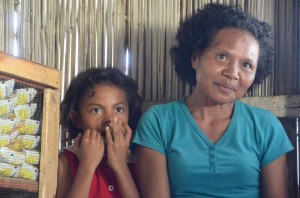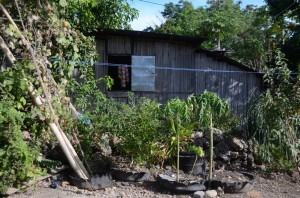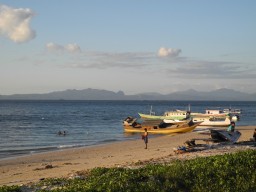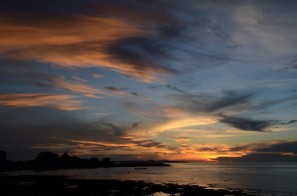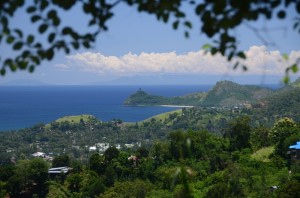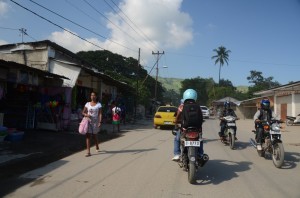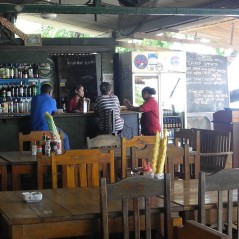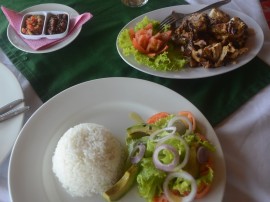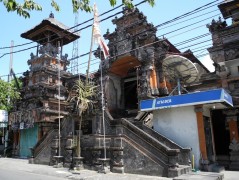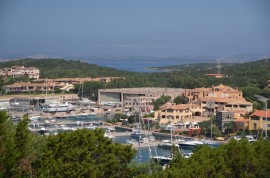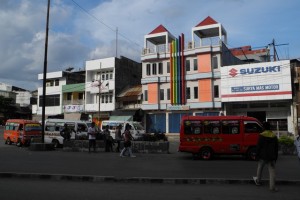Archive
One in a Few Billion.
I’ve written a few blogs about my experience as a Kiva Fellow in Timor, but I haven’t written directly about a typical borrower in this very poor region. So as I wrap up this fellowship with Kiva, I’m taking this opportunity to fill that gap.
The borrower you’re about to meet lives within the city limits of Kupang on the western tip of Timor. Kupang is the provincial capital of Nusa Tenggara Timur which includes the western half of Timor, the islands of Flores, Sumba, Alor, Rinca, Komodo and 560 other small islands. NTT is the poorest province in Indonesia, but it is a beautiful place. Jagged mountain skylines (mostly volcanic, though Timor is not) are bounded by coral reefs, isolated and deserted beaches, and rich turquoise seas.
The Kiva micro-finance partner in Kupang, Tanaoba Lais Manekat (“Serving With Love” in the local Dawan language) has been operating since 1995. TLM has grown to 30 branches operating on six islands serving 7,000 clients. At this writing there are 410 active Kiva loans which will expand to about 700 as TLM uses all of the loan capacity now available to them. The average Kiva loan is about $650 and is repaid in just over two years.
Blandina has been a TLM/Kiva client for several years. She is 46 and raising six children spanning the ages of 6 to 18. She exemplifies someone who was at risk of slipping into poverty and was unfortunate enough to find herself there.
Ten years ago she would not have considered herself poor. Although they lived in a humble house, her husband, Oktovianus, worked as a mason. Together with her income as a sales clerk, and a small goods business in the local market they were able to support their family.
But a few years ago Oktovianus passed away after a long illness which drained the family savings and forced them to sell their home. Blandina was left with nothing and needed to support her children by herself. Her own illness forced her to leave her job as a sales clerk, so to meet expenses she went door to door washing clothes.
The earnings from washing just wasn’t enough, so she began to generate a bit more income by opening a kiosk business from the home she now rents. It’s a small operation selling home-made snacks and baked goods (her spicy fried corn is especially yummy), instant noodles, toiletries, staples like salt and sugar, candies and other items. She began with her own capital and borrowed about $300 through TLM and Kiva to increase her stock and build a larger customer base.
After housing and feeding her children, keeping them in school has been Blandina’s primary concern. She has a unique savings system where money earned from each of her activities is put in a different colored box for different expenses – one of these is for tuition. She also has savings in TLM’s deposit program.
She recently took out her fifth loan and will be using the $400 to expand her income activity by buying piglets to raise and fatten for re-sale.
The income from her various businesses has allowed her to meet her goal to keep her children in school. Unfortunately, her oldest son recently graduated from high school and is not able to attend university – he’s working as a fare collector on one of the local mini-buses to help with family expenses.
Blandina is hoping that continuing support from TLM and Kiva’s lenders will help her build a better future for her other children. She is certainly working hard to make that happen.
If you haven’t looked into Kiva, you might take this opportunity to do so. It’s an easy method to help the neediest people directly through Kiva’s partners worldwide. It has been proven for many years that micro-finance works – micro-loans enable people to help themselves. It would be great if you could make a loan for as little as $25 to one of the billions of poor people like Blandina throughout the world.
Go to Kiva.org and meet someone like Blandina. Loan them a few bucks. It isn’t tax deductible because you get it back.
More pictures of NTT here: NTT Photos
Artificially Sweetened Development
Usually when I’ve been in places that I declare to be “artificial” I am thinking of a Disney theme, or a place like Cabo San Lucas or Cancun – southern California or Florida transported to Mexico – a place which bears little resemblance to what it would be like if it weren’t for the tourist dollars it was created to attract. Of course, Las Vegas is the archetype for turning a desert into a sweet water oasis, of sorts.
Shopping malls are artificial in that they are sterile replacements for shopping streets. Modern shopping areas have turned most American cities into a Warhol-like canvas of indistinguishable images in slightly different hues. Show me a Walmart and there’s a Taco Bell not far away.
Dili, the capital of Timor-Leste, is an artificial place, but in a different way. The city (and much of the country) was destroyed after the rampage of pro-Indonesian militias following the 1999 independence referendum. (This followed a period of brutal repression highlighted by a concerted effort on the part of the “international community” to look the other way. Most notably Australia, the only country in the world to officially recognize Indonesia’s sovereignty, by a thirst for oil and gas in Timor’s offshore fields. And by the US in the post-Vietnam cold war era where Suharto was just about the last regional dictator available to support.)
Post-independence civil strife in the middle of the ‘naughties didn’t help. Today there are only a few remaining scars of that time – a few scorched buildings – and it is a fairly bustling place of a few hundred thousand inhabitants.
What exists today would not exist without the huge influx and efforts of UN peace keeping forces, NGO’s and aid agencies of every stripe and nationality. There is not a school or public building without a flag or plaque commemorating the foreign entity that paid for it. Some of it was direct aid like the central post office – paid for by South Korea. More recently large commercial investment has appeared. The first shopping mall and cinema (just opened late 2012) was built by Singapore developers. (You can tell it’s Singaporese because guests going from the ground floor reception desk to the elevators for the upstairs hotel must walk through the shopping center. And some rooms have lovely balconies with windows either facing a blank wall, or blocked by billboards.)
I’m sure there was a great deal of planning on the part of those responsible for the rebuilding, and I don’t suggest that it was not noble, humanitarian, right, and helpful to the government and people of Timor-Leste to have done this. But it is certain that what exists here today would not have sprouted from local, organic development.
Any cultural expression is limited to a few places where traditional woven cloth (tais), baskets and carvings are sold. Notable among them is the Alola Foundation created to raise awareness of sexual violence against women and girls as a result of the militia rampages of 1999 www.alolafoundation.org. A new “Timorese Resistance Archive and Museum” (paid for by Portugal and Macau) relates the long struggle for independence. (A little ironic when you consider that Timor-Leste and Macau were Portuguese colonies for over 400 years.)
The consequences of this development are a little strange, though not immediately apparent in a quick visit. For the most part, tourists are rare, and what exists in Dili exists to support the international workforce. Supply of services is highly skewed toward them and their expense accounts.
When UN workers first arrived, there was no place for them to stay, and they were lodged on ships moored just offshore. Building “tourist infrastructure” is one of the areas where aid was and is applied. And though priced at international rates, it is not of high standard. In the poorest country in one of the poorest regions of the world, my room cost a whopping $850 per month (a slightly larger room with a chair, sofa and table was $400 more). Similar lodging on the Indonesian side of the island costs less than 1/3 of that. The main difference being the lack of a large foreign aid workforce.
The UN left in December of 2012. I wasn’t there before they pulled out, so I can’t say how different it is today, but all of the beach side tourist restaurants are running at idle. There are few customers.
From the viewpoint of someone assigned there, even for just a brief period as I was, it was very nice to find the Chinese-owned grocery store shelves filled with imported goods – mostly from Portugal (great sardines and olives). And I did find Skippy peanut butter, both Smooth and Crunchy.
One of the things I pictured in my mind before arriving here was wonderful grilled seafood. And there was a lot of fresh fish being pulled out of the sea and for sale along the beachfront road. But it was never on ice, often in the sun, and as the day wore on, the smell of spoiling fish filled the air. I never had a really good piece of fish in Dili, and I think most of what I got was a frozen import. You could even get five varieties of imported Portuguese dried bacalau in one of the markets.
For a short jaunt from town on a weekend I could often be found riding my motorbike 10km east along the beach to “the Jesus statue” – a 27m tall copy of the one in Rio – and back.
Stopping for lunch in one of the beach bodegas usually meant a pretty long wait if I ordered anything more exotic than nasi goreng (fried rice). The cook didn’t keep much food on hand – it would likely go to waste for a lack of customers. She had to send out to buy anything I ordered. The chicken was a good bet to be fresh since it came back from the market still clucking.
About 70% of the population of Timor-Leste lives on less than $2.50 per day. Coincidentally, an ice cream cone at the new mall costs $2.50. The lunch special at The One More Bar is $5.00. Most lunches out cost $8-10, though the $6.50 buffet at the City Cafe was the best deal. (I think The OMB was named with the intention of prompting you to order “one more,” but I interpreted it as “just another bar.”)
I have no survey data to support this statement, but I think I am safe in saying that 99.5% of the local population cannot participate in this economy. This is the symptom of big money aid. It doesn’t address the bulk of the population. It papers over things and gives a false sense (not in all ways) that progress has been made when, in fact, most people have been left behind.
It’s the Law of Unintended Consequences.
Good time for a Kiva plug (www.kiva.org). The reason I was in Dili was to work with Kiva’s micro-finance partner Tuba Rai Metin (tubaraimetin.com) to improve their reach to the people left behind. I suppose my time was well spent since TRM will soon be offering Kiva loans in all 13 national districts (before they were only offered in 2), and their available fundraising limit with Kiva was more than doubled. The next time you make a Kiva loan, be sure to look for borrowers in Timor-Leste.
Splitting my time as a Kiva Fellow between Timor-Leste and west Timor, Indonesia, I had two options for moving to Kupang in the west. Either a horrendous 12 hour bus ride, or a flight to Bali and a flight back to Kupang. A couple of days R&R on Bali sounded like a good plan, so I booked a hotel in Sanur, an area I hadn’t stayed in before.
Bali is a different definition of artificial. Perhaps it’s just over-developed. I don’t know where the development dollars are from, but there were (and are) a lot of them. The whole southern end of the island is one traffic jam in streets full of foreign shops and throngs of paradise seeking vacationers and the people to support this industry. Yucch.
The “real” Bali is to be found inland or along the coastline well away from over-developed Denpasar, Kuta, Legian and Sanur. But does “the real” (old) Bali still exist? Doubtful. Maybe just a shadow of it.
Whether or not it is, I don’t know, but the development seems more home grown here. Even with all the tourist mod-cons and brand name shops, the building seems more in line with Balinese ideas.
Bali was probably a nice hideaway at one time, but it is a perfect example of why you should keep your mouth shut when you find someplace nice.
I ran into another aspect of this last year in Sardinia. The northeastern coast, La Costa Smerelda, was scrub land picked up by the Aga Khan in the 1960’s for next to nothing. He developed it into a characterless resort town, touted it, and today it’s a destination for the rich, the famous, the wannabies, and cyclists with only one coastal road to choose from.
But I was also curious to see how the other, other half lives, and to check out the advertised splendor of the scenic coast. I was really disappointed. It’s scrub land. There are far more beautiful places in Sardinia than that (and I’m not going to tell you where).
It just shows you what good marketing and the general desire of humans to gather into amorphous clumps, dress alike, drink beer and proclaim their superiority can do, though I guess the clientele there has a better claim on the latter than the rest of us.
So I was really interested to see what Kupang would be like – only 175 miles (280 km) as the crow flies from Dili. There are no tourist brochures touting it as a destination. I’ve only been here about ten days, but I can say it is real. There’s nothing in Kupang that I can interpret as put on, or existing only to serve a foreign audience. OK, there’s Teddy’s Bar down on the water, but it ain’t much.
Kupang is a noisy, bustling place. It is the business center and capital of Nusa Tenggara Timur – the poorest province in Indonesia. The nicest hotel in town is rather unremarkable and worn. The budget places are a little scary. The only foreign restaurant chain I’ve found is KFC, and there are far fewer foreigners around, though almost all of those are aid workers. There are many little snack places, and the restaurants are patronized by local people and families – a very rare sight in Dili.
You can get fresh fish in the supermarket, on ice, and you can even get Skippy (smooth only). The very nice Borneo Bakery sells local product, not imitations of perceived foreign tastes. As an added bonus, the mosquitoes seem to be more plump and juicy and crackle more dramatically when hit with my zapper.
Missing from the landscape are the white Toyota Land Cruisers with UN or other logos on the doors and hood, careering around town with little regard for anyone else.
A surprising absence in traffic are taxis. They were everywhere in Dili and always honking to get attention. I’ve seen just a couple in Kupang, but the population of motorbikes is higher here, and the traffic worse. Taxi’s must have sprouted in Dili to serve the needs of the foreigners. The normal city public transport in both places are mini-buses – mikrolets in Dili; bemos in Kupang. (The “bus, coach & minibus” section of my phrase book offers the helpful, “You’re on my foot.”)
So, as I dig deeper into the place over the next few weeks, I’ll monitor how I feel about reality. I’ll have the chance to do that while I’m working with Kiva partner Tanaoba Lais Manekat (ytlm.org). My main task will be to perform a “borrower verification” – meeting with 10 current Kiva-TLM borrowers spread from Sabu to Niki-Niki. And I’ll be discussing ways TLM can take advantage of Kiva’s lender base to improve their reach to the poorest of the poor.

